Oz Four Ways: The Wizard Of Oz
From the Travel Guide:
 Oz as you’ve never seen it before! Experience the kaleidoscopic culture of the the Land Over The Rainbow and immerse yourself in the vivid color and music casual tourists can only dream of! Dance with the Munchkins! Sing with the merry citizens of Emerald City! Experience a private audience with the Great and Terrible Oz Himself! Soar with the Flying Monkeys! Come face-to-face with the poisonous green embodiment of nastiness herself, the Wicked Witch of the West, and live to tell the tale! When your adventure is complete, our express travel service will whisk you back home in the blink of an eye, but your memories of Oz will last forever, inspiring happy dreams for years to come!
Oz as you’ve never seen it before! Experience the kaleidoscopic culture of the the Land Over The Rainbow and immerse yourself in the vivid color and music casual tourists can only dream of! Dance with the Munchkins! Sing with the merry citizens of Emerald City! Experience a private audience with the Great and Terrible Oz Himself! Soar with the Flying Monkeys! Come face-to-face with the poisonous green embodiment of nastiness herself, the Wicked Witch of the West, and live to tell the tale! When your adventure is complete, our express travel service will whisk you back home in the blink of an eye, but your memories of Oz will last forever, inspiring happy dreams for years to come!
Metro Goldwyn Meyer’s 1939 movie, The Wizard of Oz, is one of the most iconic movies in American filmdom, beloved by viewers of all ages. Though it was reasonably faithful to L. Frank Baum’s The Wonderful Wizard of Oz, which we toured last week, it illustrates how a story often mutates in its transition from print to film, for both better and worse, and how its tone and message are subtly (or sometimes not so subtly) altered. Here’s a quick summary of some of the major differences, and I’m sure I’ve missed more than a few. Feel free to add your observations to this list:
 Dorothy is portrayed by Judy Garland as a pre-teenager rather than a little girl. Kansas bores her. She longs to escape the featureless, monochrome prairie and fly away to a land “somewhere over the rainbow,” and to top it all off, the lady down the road is a spiteful grouch who wants to dispose of Toto.
Dorothy is portrayed by Judy Garland as a pre-teenager rather than a little girl. Kansas bores her. She longs to escape the featureless, monochrome prairie and fly away to a land “somewhere over the rainbow,” and to top it all off, the lady down the road is a spiteful grouch who wants to dispose of Toto.
The Munchkins are “little people,” not slightly-undersized adults, and they’re engaged in a variety of whimsical pursuits rather than being staid, industrious farmers.
We don’t meet the Witch of the South, and a very pretty Glinda, played by Billie Burke, assumes the role of Witch of the North, who was a wrinkled old lady in the original story.
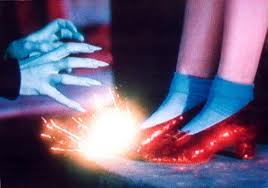 The silver shoes are now ruby slippers, since red looks cooler in Technicolor. They are magically bonded to the wearer and cannot be removed forcibly save by the death of the wearer. When the Witch tries to snatch them, they generate an impressive electrical force-field.
The silver shoes are now ruby slippers, since red looks cooler in Technicolor. They are magically bonded to the wearer and cannot be removed forcibly save by the death of the wearer. When the Witch tries to snatch them, they generate an impressive electrical force-field.
The Scarecrow and Tin Woodsman are pretty much as advertised, thanks to some beautiful makeup work and a tour-de-force of rubber-legged dancing by the great Ray Bolger as the Scarecrow. The Lion is a guy in a lion suit, but it’s the delightful, rubber-faced Bert Lahr, so we don’t mind so much. Jack Haley plays the Woodsman as a bit of a milquetoast, and one wonders how Buddy Ebsen would have done in the role had he not suffered a life-threatening allergic reaction to his silver makeup that forced him to bow out.
The Witch of the West is scary, and Margaret Hamilton’s performance continues to spawn nightmares and damp sheets for succeeding generations of youngsters. She looks like a conventional witch (black robes, broad-brimmed pointy hat, green skin, wart, and long fingernails), and she’s capable of numerous magical feats, including manipulation of nature (she creates a poisonous poppy field as a trap for Dorothy and her friends, rather than naturally-growing wildflowers with tranquilizing properties), flight using a magic broomstick, fireball casting, crystal ball scrying, and vanishing herself in a puff of smoke. She simply exudes mean, a quality lacking in Baum’s rather pale Witch.
The Emerald City is really green. No glasses required. A Horse of a Different Color is useful for getting around town.
 The Wizard’s flimflam employs sophisticated special effects. More steampunk than puppetry.
The Wizard’s flimflam employs sophisticated special effects. More steampunk than puppetry.
Dorothy must not only kill the Witch, she must bring the Wizard her broomstick as evidence.
The Witch controls the Flying Monkeys without the need of a magic hat. That’s just how they roll.
Dorothy douses the Witch not out of anger for having one of her shoes stolen, but to protect Toto.
The Wizard rewards Dorothy’s friends a little differently. The Scarecrow gets a diploma, the Tin Woodsman gets a testimonial watch, and the Lion gets a medal. This Wizard, played by Frank Morgan, is a better psychologist than the original, and I have an easier time buying him as a well-meaning charlatan who lost his way, rather than a craven con man.
Dorothy misses her balloon ride per the original story, but her tedious trek through the southlands is replaced by the more efficient, if campier, deus ex machina of Glinda’s arrival in a magic soap bubble. The ruby slippers return Dorothy to Kansas after a little prompting from Glinda, who doesn’t have a good reason for not telling Dorothy about the slippers’ power at their first meeting. A really Good Witch would have ‘fessed up. Just saying. In the original, the Witch of the North hadn’t a clue how they worked, thus the trip to see the Wizard and everything else.
Dorothy awakens in her own bed. It was all a dream! Uncle Henry’s three hired hands (another addition) bear a suspicious resemblance to her three companions from Oz, and the local flim-flam man pays her a visit, just to make sure we get the point. The cranky neighbor doesn’t turn up, but we all know what role she played in the dream (wink, wink, nudge, nudge). Dorothy announces that she’s learned her lesson and will no longer go searching for happiness beyond her own back yard, because there’s no place like home. The End.
A few more contrasts between the film version and the novel:
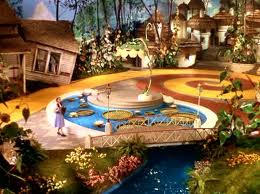 Color, Color, Color! And lots of it. The film makes extravagant use of the vivid hues available via the Technicolor process, and it’s bold, brassy, and loud. The transition from sepia-toned Kansas to the garish sensory overload of Oz is mind-shattering, and must have been even more so for the first audiences. Oz looks so good, one wonders why Dorothy ever wanted to leave it. It’s also a tribute to the wonder of dreams and imagination, at least for those of us with the good fortune to dream in color.
Color, Color, Color! And lots of it. The film makes extravagant use of the vivid hues available via the Technicolor process, and it’s bold, brassy, and loud. The transition from sepia-toned Kansas to the garish sensory overload of Oz is mind-shattering, and must have been even more so for the first audiences. Oz looks so good, one wonders why Dorothy ever wanted to leave it. It’s also a tribute to the wonder of dreams and imagination, at least for those of us with the good fortune to dream in color.
Song and Dance. Music and movement are used effectively to convey emotion, as a shorthand way to introduce and develop the characters, and to liven things up. They help preserve Baum’s desire for a lighthearted tone, and by contrast, their absence makes the scenes of conflict with the Witch seem more scary and threatening. Judy Garland’s signature rendition of “Over the Rainbow” won an Academy Award for Best Song, and the film was also awarded an Oscar for Best Original Music Score.
The Morals of the Story. There’s no such thing as an implied moral in this presentation. The messages are delivered directly and explicitly to the audience. The original theme of Good’s power over Evil is discarded in favor of an invented lesson for Dorothy, though it’s noted that “only Bad Witches are ugly.” The Big Idea is that, even as we sympathize with our heroine’s plight…who would want to live in Kansas, that dry, dusty, flyover country populated by earnest hayseeds?…we must remember that the true road to happiness is accepting our lot in life and treasuring the friends and family closest to us.
In similar fashion, the observation that the three companions already possessed everything they thought they lacked is amplified, particularly in the Wizard’s little speech as he distributes their awards. It’s a better speech and more clever set of solutions, in my opinion, than the original Wizard provides, especially as there’s no need to fill Ray Bolger’s head with bran and needles. I’m sure he was thankful for that.
In sum, the film’s message is sort of a lightweight version of Phillipians 4:11-13, minus the connection to God’s power and grace that makes it more than a nice sentiment. It’s one thing to say you’re going to be content with what you have, and quite another thing to live that way, whether in Kansas or Hollywood.
Next week, we’ll explore the dark underbelly of Oz, via Gregory Maguire’s Wicked: The Life and Times of the Wicked Witch of the West. Check your insurance policy, and be prepared to sign a liability waiver. Just saying.

































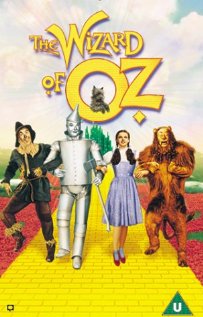
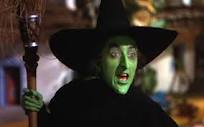



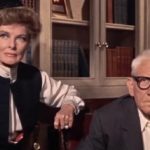



Nice analysis! It made me almost want to go watch it again. Except I think of the scene with the flying monkeys and its possible effects on the psyche of my kids. And I changed my mind.
Understandable. I avoid monkeys of all flavors, including sock. Also clowns.
When I was in school I had a worldview curriculum* which required me to watch and analyze this film, with a somewhat different message in mind from yours. The curriculum posited that the Wizard is a sort of god-figure, and the moral of the story is that God’s a sham, and we all have the intelligence, courage, love, etc. we need inside of us already and have no need of God. So ever since then that is how I’ve seen this film! Hence I strongly dislike this movie, although that might also be due to my distaste for the “Somewhere Over the Rainbow” song…
Regardless of the difference between my curriculum and your post, I thought your analysis was interesting and quite good! 🙂
— Bethany
*The curriculum is David Quine’s “Starting Points” (followed by “World Views of the Western World,” the high school curriculum). The teaching style and actual design of the books is lacking sometimes, IMHO, but it taught me a TON, and started a lifelong fascination with philosophy, theology, and worldviews. It was my favorite subject all through junior high and high school.
I never though there was an old version of wizard of Oz back then. Who were the great stars who played the main characters of the story? I hope they’ll be able to remake one in the future.
-Ryan
Ryan, You can find information about the cast and crew of the movie here: http://www.imdb.com/title/tt0032138/
Bethany,
That’s not an unreasonable approach to interpreting this film, though it seems to run counter to the filmmakers’ pains to tell us, via Dorothy and the Wizard, exactly what it all means. And the Wizard did give them something they needed and didn’t have (confidence), but not in the way they expected.
Of course, the great pitfall in any attempt to analyze a work of art in isolation from its creator(s) is the tendency to find what you expect to find, and I’m subject to the same bias. Since I approach this from a Christian worldview, I’m going to pay attention to images that resonate with that, and glean lessons that reinforce it. I’m an optimist besides, so I’m going to bend over backward to find positive elements.
I think it’s possible for two people to look at a work of art and walk away with two very different impressions of it, both valid. It’s not that truth is relative–it’s more like looking into the same house through two different windows. The kitchen may be beautiful and the master bedroom a wreck.
Fred
It was interesting to read the book for the first time, and I plan on rewatching the movie soon. I’m not so keen on Wicked, though. It’s going to be interesting to see you try and get a Christian take on that book.
There’s actually quite a lot to talk about…the question of who or what is controlling events in Oz is an undercurrent throughout the entire story, and religion plays a prominent role as well. Both issues were completely absent from the original novel and the movie. And there’s the central question of what exactly “wickedness” is and whether the Witch was born wicked, chose to be wicked, or was molded into wickedness by forces beyond her control.
Finding positive themes that align with a Christian worldview, though, is more difficult, and it’s not a book I’d recommend for family reading.
I saw a trailer of this film–oh man, it looked absolutely terrible.